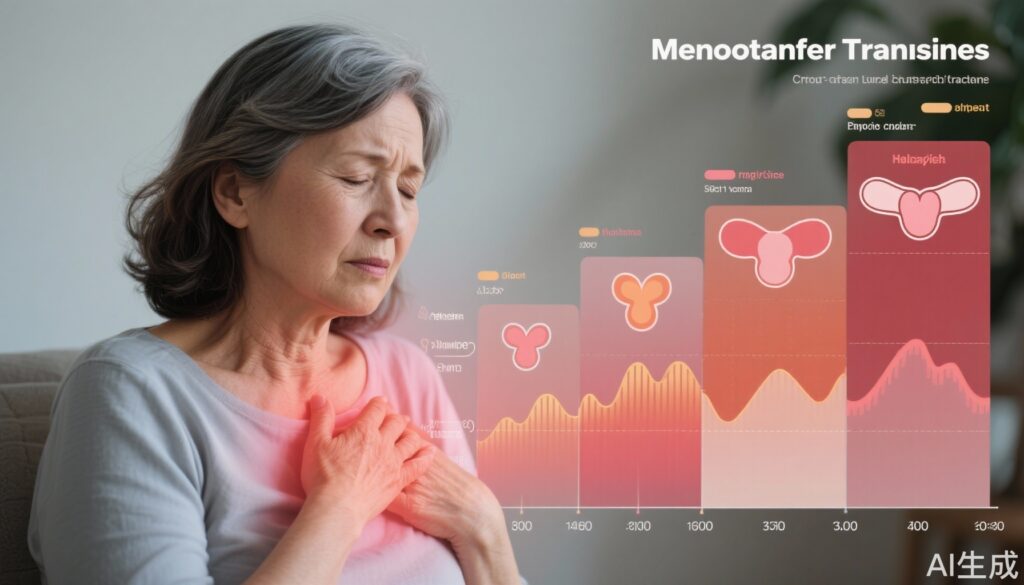Study Background and Disease Burden
Menopause marks a significant transitional phase in women’s reproductive lifespan, often accompanied by diverse symptoms affecting quality of life. Clinically, the transition from premenopause to perimenopause is traditionally defined by the Stages of Reproductive Aging Workshop +10 (STRAW+10) criteria, emphasizing altered menstrual cycle frequency. However, this cycle-centric approach presents challenges, especially for women and gender-diverse individuals experiencing oligomenorrhoea or amenorrhoea, where menstrual patterns may be irregular or absent. Moreover, menopause is associated with a broad spectrum of symptoms including vasomotor disturbances, mood changes, cognitive complaints, and sexual dysfunction, complicating the clinical characterization and management of menopause onset.
The burden of menopausal symptoms is significant, impacting daily functioning, mental health, and long-term well-being. Accurate identification of menopausal transition stages is paramount to guiding effective therapeutic interventions and optimizing care pathways. Yet, there remains a gap in robust symptom-based markers that can reliably signal menopausal onset beyond menstrual changes, particularly in populations with irregular menses.
Study Design
The Australian Women’s Midlife Years (AMY) Study is a nationally representative cross-sectional investigation designed to elucidate the prevalence and severity of menopausal symptoms across reproductive aging stages. Conducted between October 27, 2023, and March 19, 2024, the study recruited 8,096 women aged 40-69 years through a non-probability panel encompassing online and offline recruitment methods. Eligibility required participants to complete questionnaires in English.
Menopausal symptoms were quantitatively assessed via the Menopause-specific Quality of Life (MENQOL) questionnaire, a validated instrument capturing symptom prevalence and severity over the preceding four weeks. Participants were classified into reproductive aging stages—premenopausal, early perimenopausal, late perimenopausal, and postmenopausal—based on the STRAW+10 criteria. The study employed statistical adjustments for age, body mass index (BMI), and other demographic variables to refine symptom prevalence ratios and confidence intervals (95% CIs).
Key Findings
Among the 5,509 women classified by STRAW+10 staging, key symptom prevalence shifts were discerned. Hot flushes emerged as the most pronounced vasomotor symptom, increasing substantially from 8.8% (95% CI 7.2-10.4) in premenopausal women to 37.3% (31.5-43.0) in late perimenopausal women, corresponding to an adjusted prevalence ratio of 4.74 (95% CI 3.64-6.19). This marked elevation underscores hot flushes as a robust symptom marker for menopausal transition.
In contrast, other symptoms such as poor memory and low mood exhibited less variation across stages, indicative of multifactorial etiologies beyond menopausal status alone. Notably, vaginal dryness was the most discriminative sexual symptom differentiating premenopause from late perimenopause, with an adjusted prevalence ratio of 2.54 (95% CI 1.78-3.61).
Subgroup analyses revealed that women experiencing vasomotor symptoms coupled with altered menstrual flow reported a higher prevalence of moderately-to-severely bothersome symptoms compared with those without vasomotor symptoms. Furthermore, early perimenopausal women with vasomotor symptoms demonstrated a greater prevalence of poor memory compared to premenopausal counterparts with similar vasomotor symptoms and menstrual changes (adjusted prevalence ratio 1.36, 95% CI 1.06-1.75), suggesting potential early neurocognitive vulnerabilities linked to menopausal vasomotor disturbances.
Expert Commentary
These findings challenge the conventional reliance on menstrual cycle changes alone to define menopausal stages and affirm the clinical utility of vasomotor symptoms, particularly hot flushes, as reliable markers of perimenopause onset—even among women with irregular or absent menstruation. This has important implications for individualized patient care and symptom-targeted management strategies.
The relatively stable prevalence of mood and cognitive symptoms across menopausal stages highlights the necessity of a holistic approach addressing psychosocial and contextual contributors. Integrating symptom-based diagnostics with patient-centric care pathways can facilitate timely intervention and improve menopause-related quality of life.
Limitations include the cross-sectional design precluding causal inference and potential selection biases inherent to non-probability sampling. Future longitudinal studies are warranted to corroborate symptom trajectories and mechanisms underlying symptom heterogeneity.
Conclusion
The AMY Study provides pivotal evidence that moderately-to-severely bothersome vasomotor symptoms serve as dependable clinical indicators of perimenopause onset, particularly in women with oligomenorrhoea or amenorrhoea. Recognizing the diverse symptomatic profile across menopausal stages invites comprehensive assessment and multifaceted management approaches. Enhancing treatment options and establishing clear care pathways remain critical to optimizing wellbeing during the menopausal transition.
References
Islam RM, Bond M, Ghalebeigi A, Wang Y, Walker-Bone K, Davis SR. Prevalence and severity of symptoms across the menopause transition: cross-sectional findings from the Australian Women’s Midlife Years (AMY) Study. Lancet Diabetes Endocrinol. 2025 Sep;13(9):765-776. doi: 10.1016/S2213-8587(25)00138-X. Epub 2025 Jul 25. Erratum in: Lancet Diabetes Endocrinol. 2025 Aug 5:S2213-8587(25)00247-5. doi: 10.1016/S2213-8587(25)00247-5. PMID: 40720963.


